THEORY OF ENGLISH GRAMMAR some schemes to be

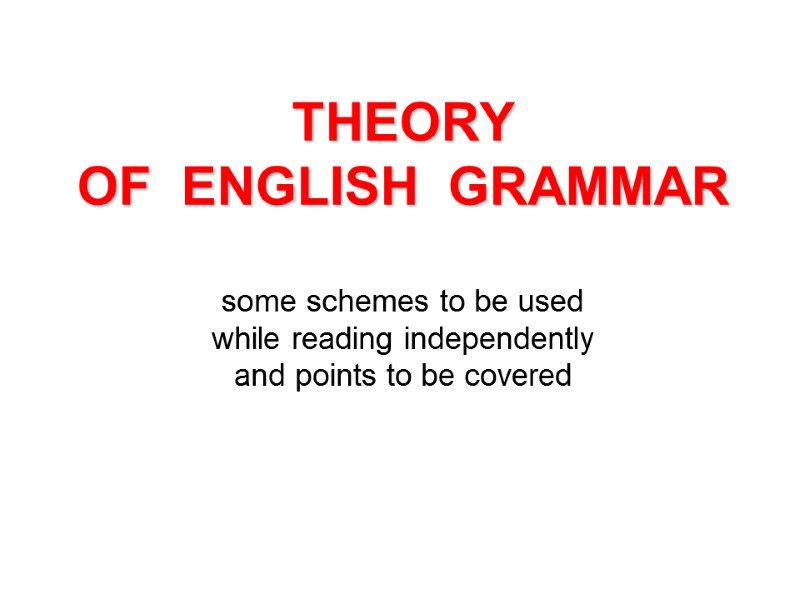
THEORY OF ENGLISH GRAMMAR some schemes to be used while reading independently and points to be covered
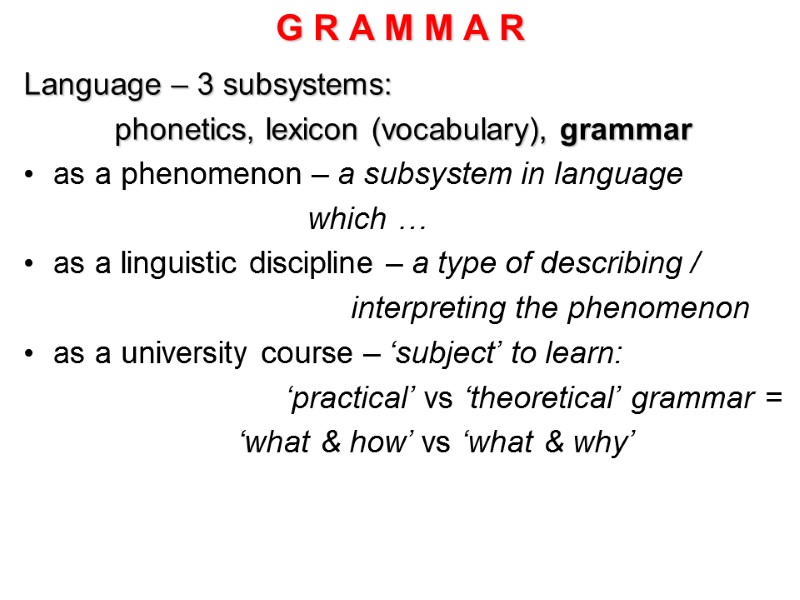
G R A M M A R Language – 3 subsystems: phonetics, lexicon (vocabulary), grammar as a phenomenon – a subsystem in language which … as a linguistic discipline – a type of describing / interpreting the phenomenon as a university course – ‘subject’ to learn: ‘practical’ vs ‘theoretical’ grammar = ‘what & how’ vs ‘what & why’
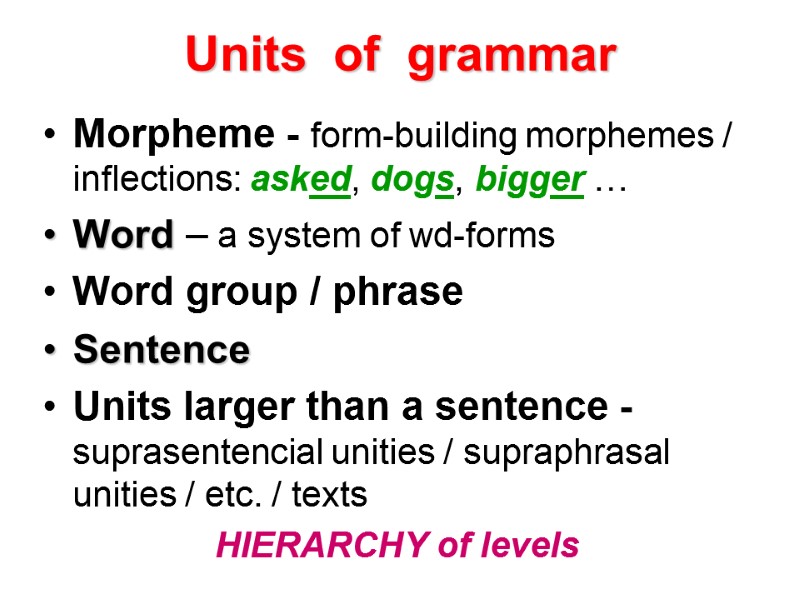
Units of grammar Morpheme - form-building morphemes / inflections: asked, dogs, bigger … Word – a system of wd-forms Word group / phrase Sentence Units larger than a sentence - suprasentencial unities / supraphrasal unities / etc. / texts HIERARCHY of levels

MAIN NOTIONS OF GRAMMAR GRAM. MEANING GRAM. FORM GRAM. CATEGORY function Any grammatical unit (единица) is a unity (единство) of grammatical meaning and grammatical form Gr.unit = gr. mning + gr.form
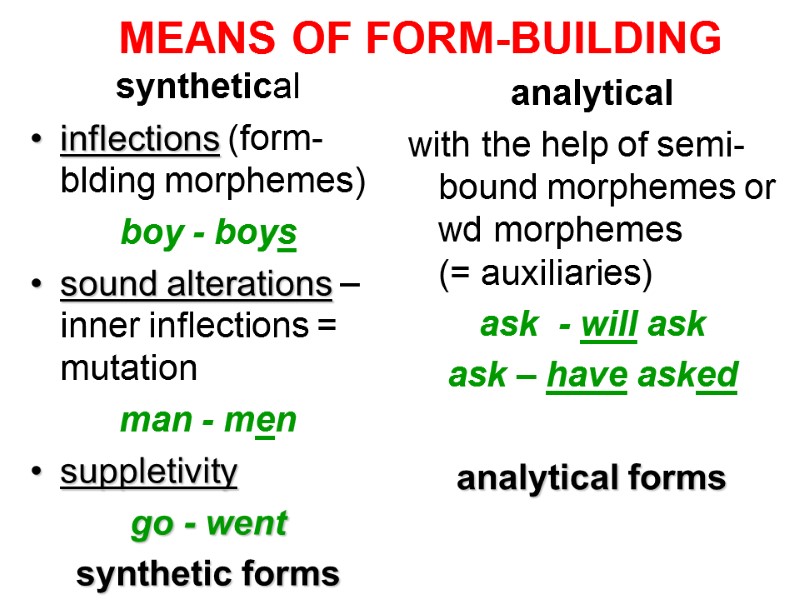
MEANS OF FORM-BUILDING synthetical inflections (form-blding morphemes) boy - boys sound alterations – inner inflections = mutation man - men suppletivity go - went synthetic forms analytical with the help of semi-bound morphemes or wd morphemes (= auxiliaries) ask - will ask ask – have asked analytical forms
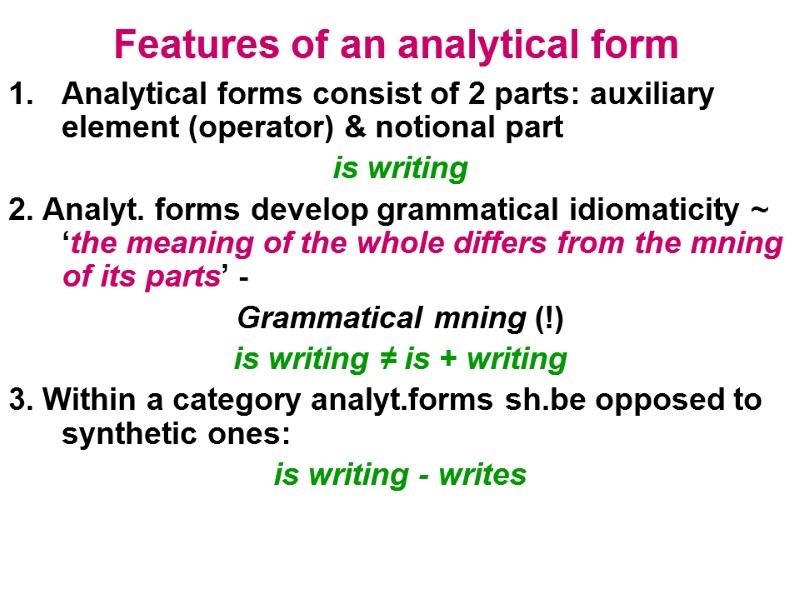
Features of an analytical form Analytical forms consist of 2 parts: auxiliary element (operator) & notional part is writing 2. Analyt. forms develop grammatical idiomaticity ~ ‘the meaning of the whole differs from the mning of its parts’ - Grammatical mning (!) is writing ≠ is + writing 3. Within a category analyt.forms sh.be opposed to synthetic ones: is writing - writes
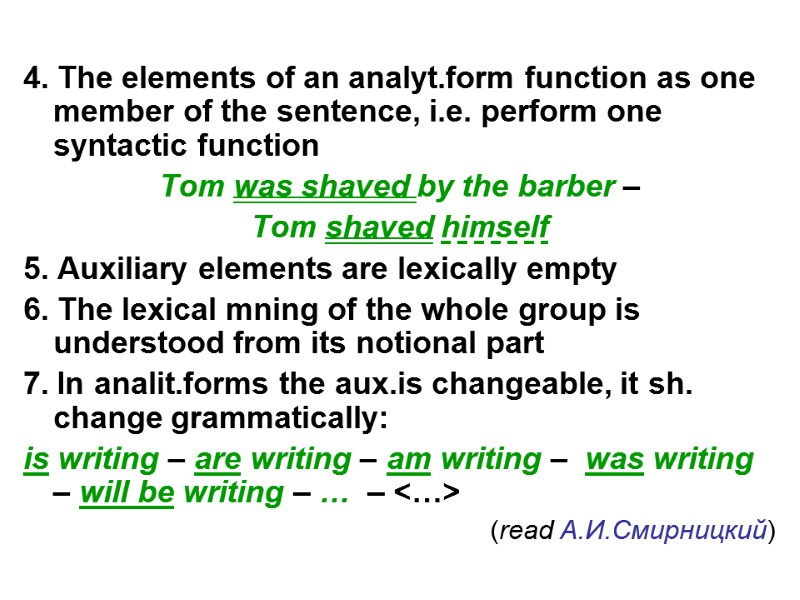
4. The elements of an analyt.form function as one member of the sentence, i.e. perform one syntactic function Tom was shaved by the barber – Tom shaved himself 5. Auxiliary elements are lexically empty 6. The lexical mning of the whole group is understood from its notional part 7. In analit.forms the aux.is changeable, it sh. change grammatically: is writing – are writing – am writing – was writing – will be writing – … – <…> (read А.И.Смирницкий)
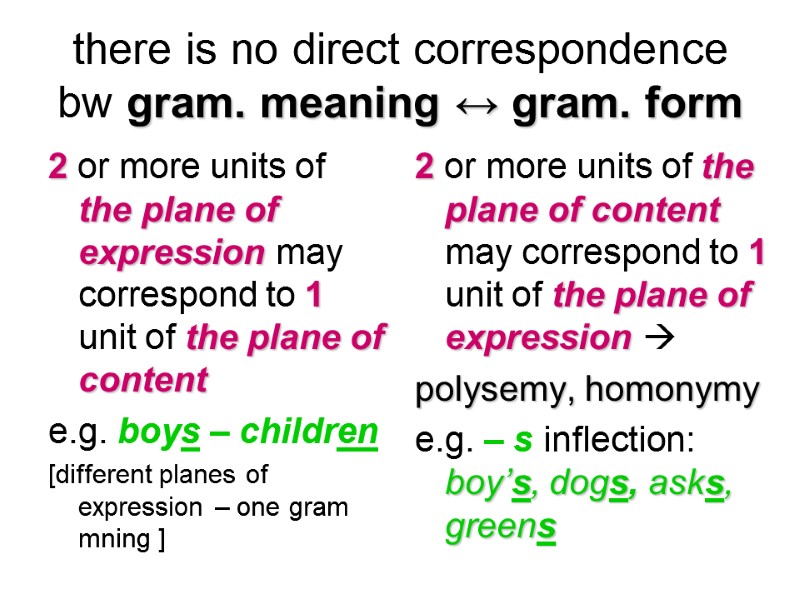
there is no direct correspondence bw gram. meaning ↔ gram. form 2 or more units of the plane of expression may correspond to 1 unit of the plane of content e.g. boys – children [different planes of expression – one gram mning ] 2 or more units of the plane of content may correspond to 1 unit of the plane of expression polysemy, homonymy e.g. – s inflection: boy’s, dogs, asks, greens
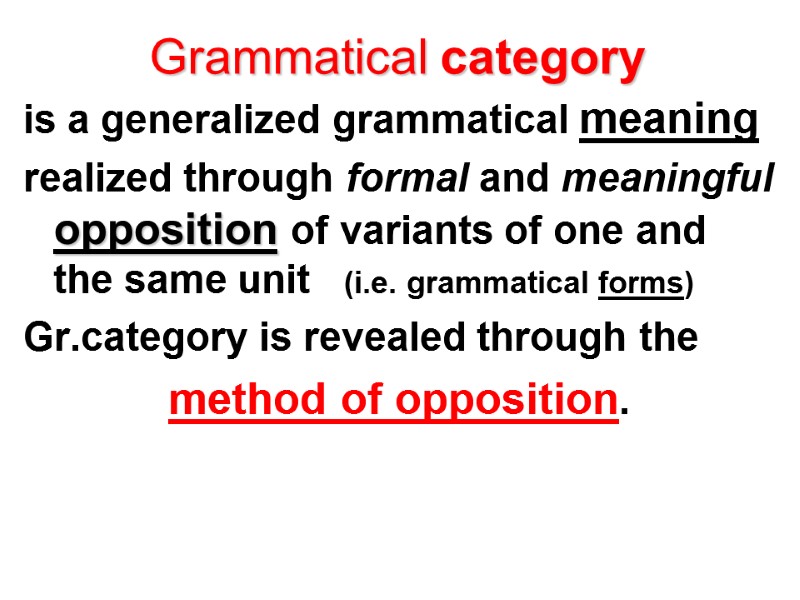
Grammatical category is a generalized grammatical meaning realized through formal and meaningful opposition of variants of one and the same unit (i.e. grammatical forms) Gr.category is revealed through the method of opposition.
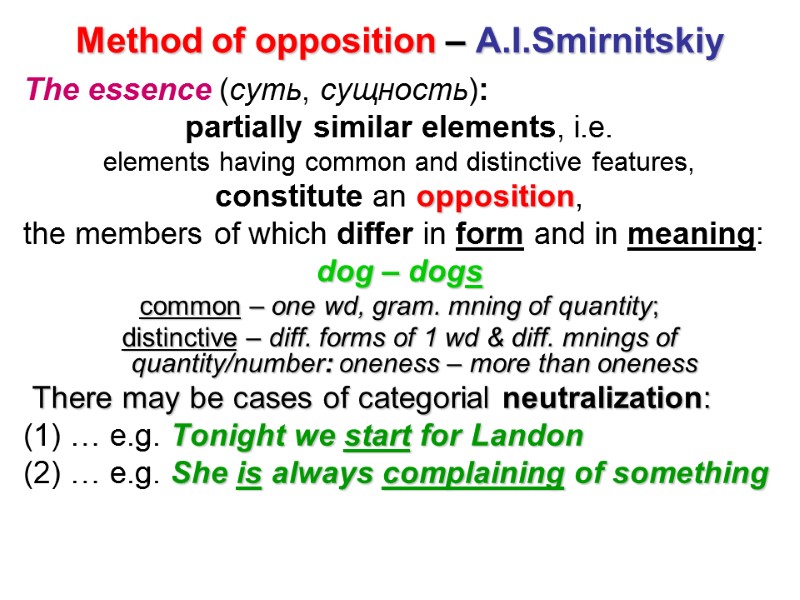
Method of opposition – A.I.Smirnitskiy The essence (суть, сущность): partially similar elements, i.e. elements having common and distinctive features, constitute an opposition, the members of which differ in form and in meaning: dog – dogs common – one wd, gram. mning of quantity; distinctive – diff. forms of 1 wd & diff. mnings of quantity/number: oneness – more than oneness There may be cases of categorial neutralization: (1) … e.g. Tonight we start for Landon (2) … e.g. She is always complaining of something
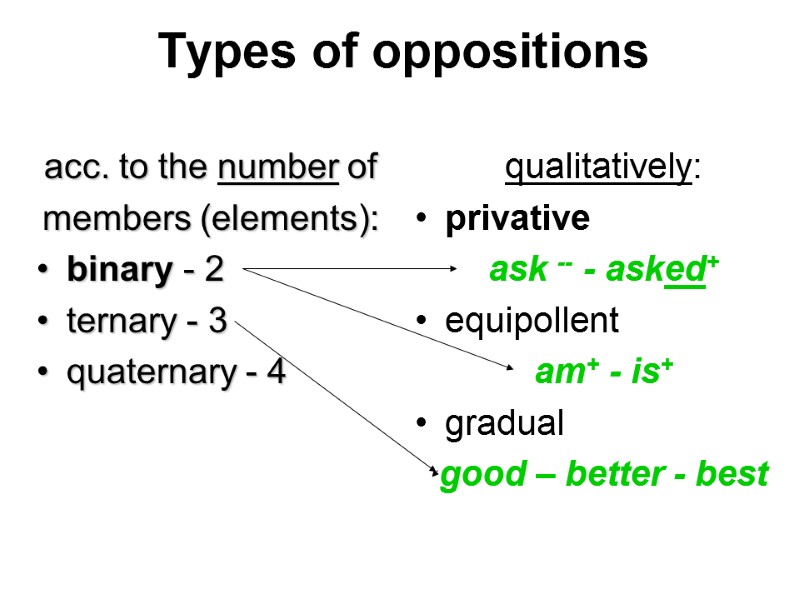
Types of oppositions acc. to the number of members (elements): binary - 2 ternary - 3 quaternary - 4 qualitatively: privative ask -- - asked+ equipollent am+ - is+ gradual good – better - best
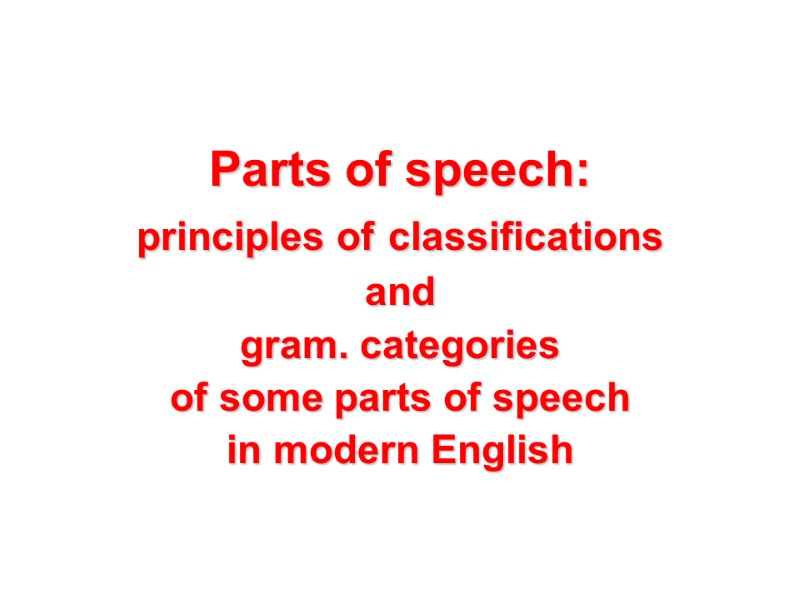
Parts of speech: principles of classifications and gram. categories of some parts of speech in modern English
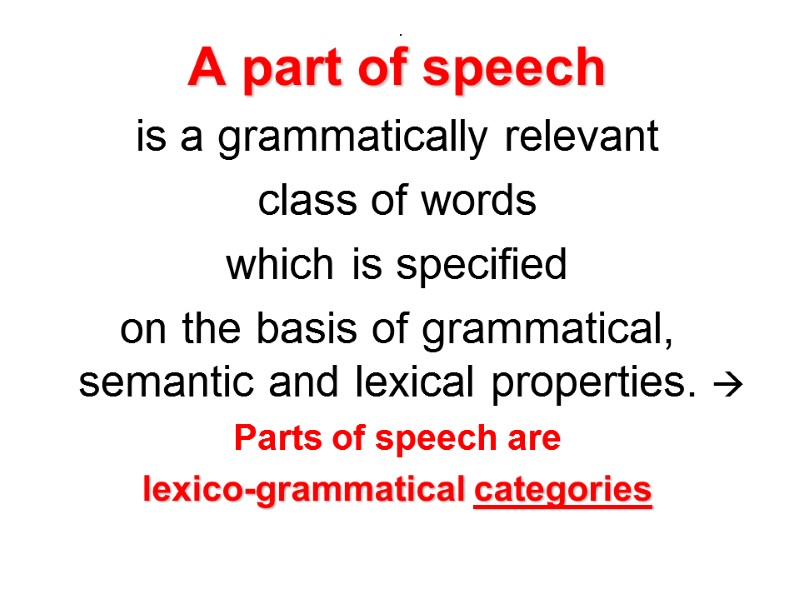
. A part of speech is a grammatically relevant class of words which is specified on the basis of grammatical, semantic and lexical properties. Parts of speech are lexico-grammatical categories
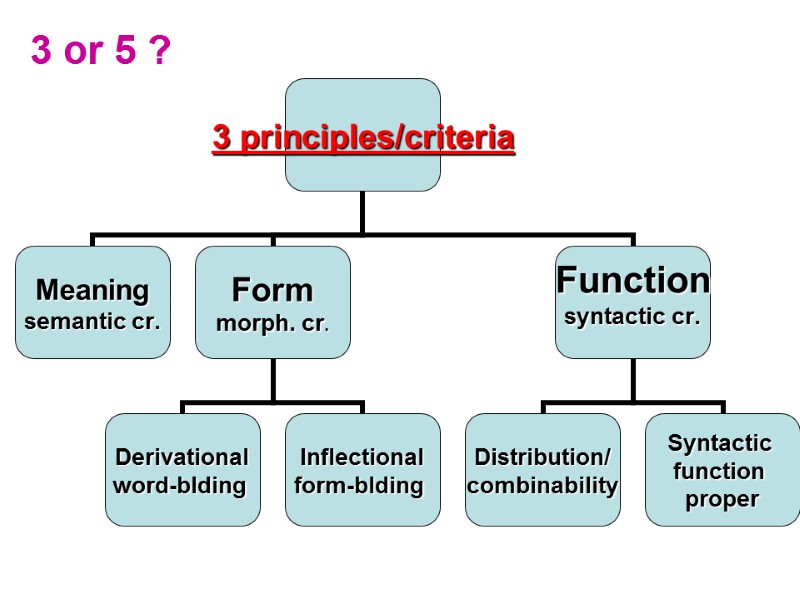
3 or 5 ?
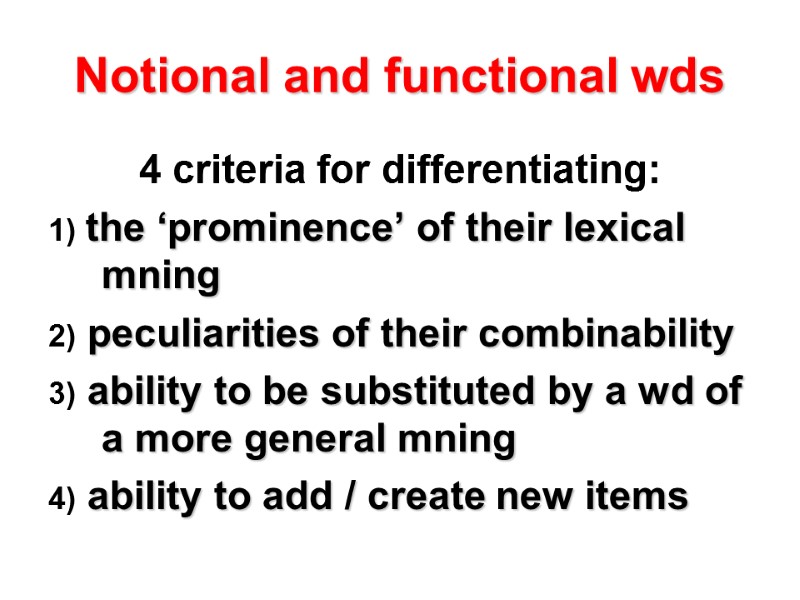
Notional and functional wds 4 criteria for differentiating: 1) the ‘prominence’ of their lexical mning 2) peculiarities of their combinability 3) ability to be substituted by a wd of a more general mning 4) ability to add / create new items
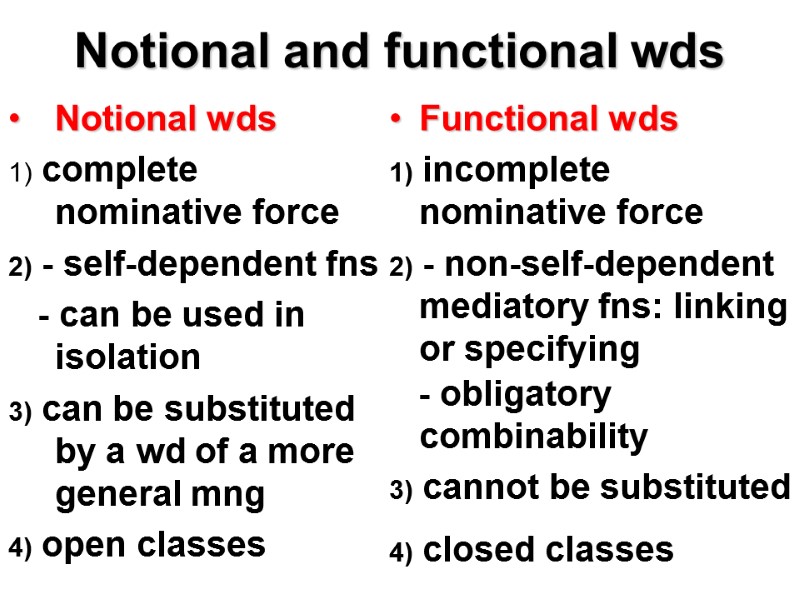
Notional and functional wds Notional wds 1) complete nominative force 2) - self-dependent fns - can be used in isolation 3) can be substituted by a wd of a more general mng 4) open classes Functional wds 1) incomplete nominative force 2) - non-self-dependent mediatory fns: linking or specifying - obligatory combinability 3) cannot be substituted 4) closed classes
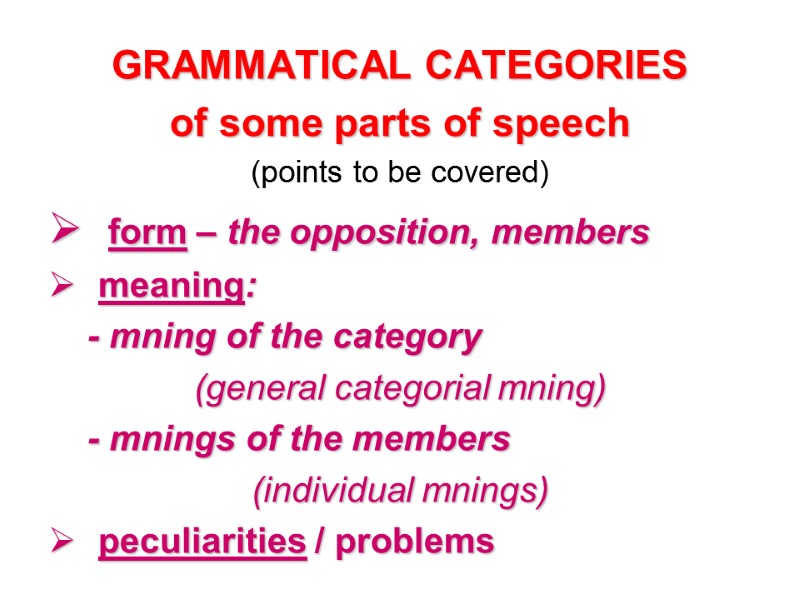
GRAMMATICAL CATEGORIES of some parts of speech (points to be covered) form – the opposition, members meaning: - mning of the category (general categorial mning) - mnings of the members (individual mnings) peculiarities / problems
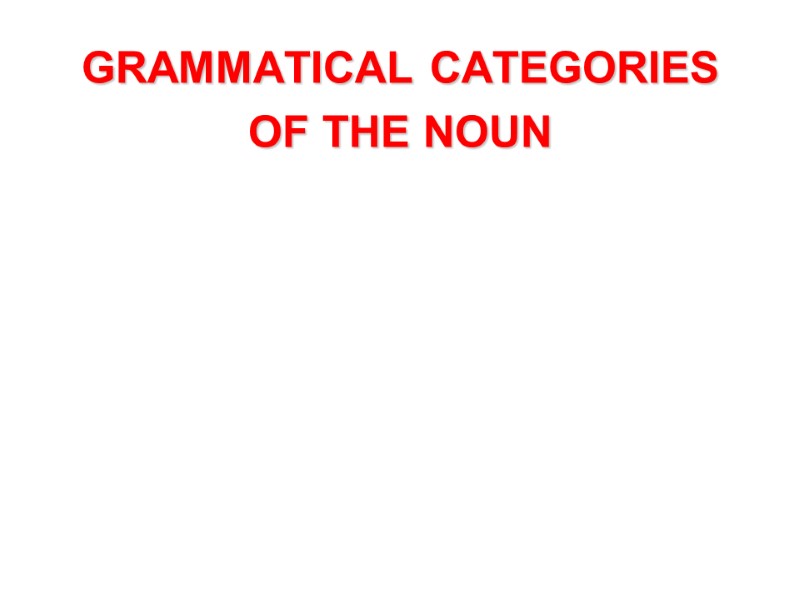
GRAMMATICAL CATEGORIES OF THE NOUN
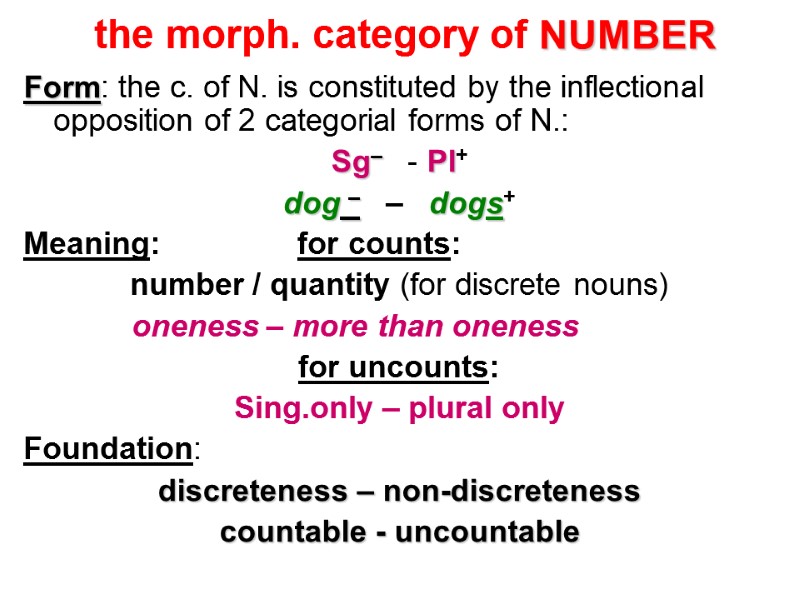
the morph. category of NUMBER Form: the c. of N. is constituted by the inflectional opposition of 2 categorial forms of N.: Sg– - Pl+ dog – – dogs+ Meaning: for counts: number / quantity (for discrete nouns) oneness – more than oneness for uncounts: Sing.only – plural only Foundation: discreteness – non-discreteness countable - uncountable
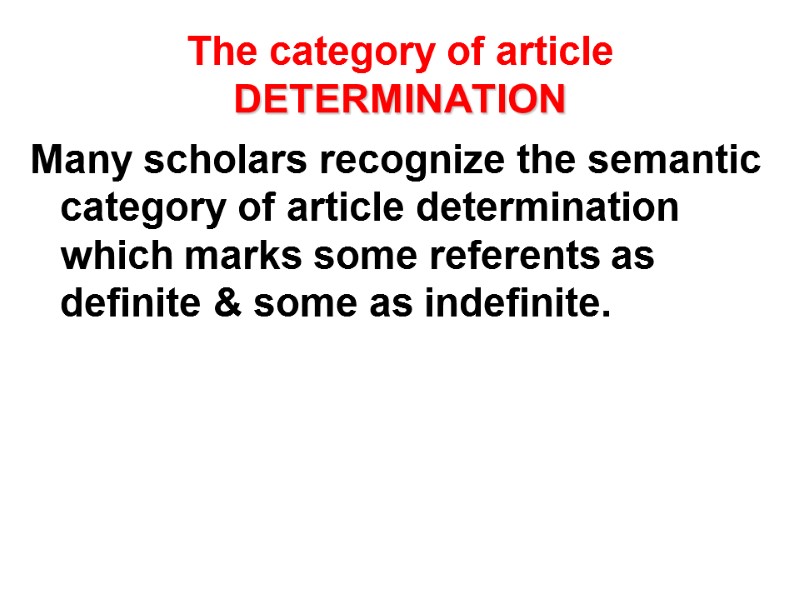
The category of article DETERMINATION Many scholars recognize the semantic category of article determination which marks some referents as definite & some as indefinite.
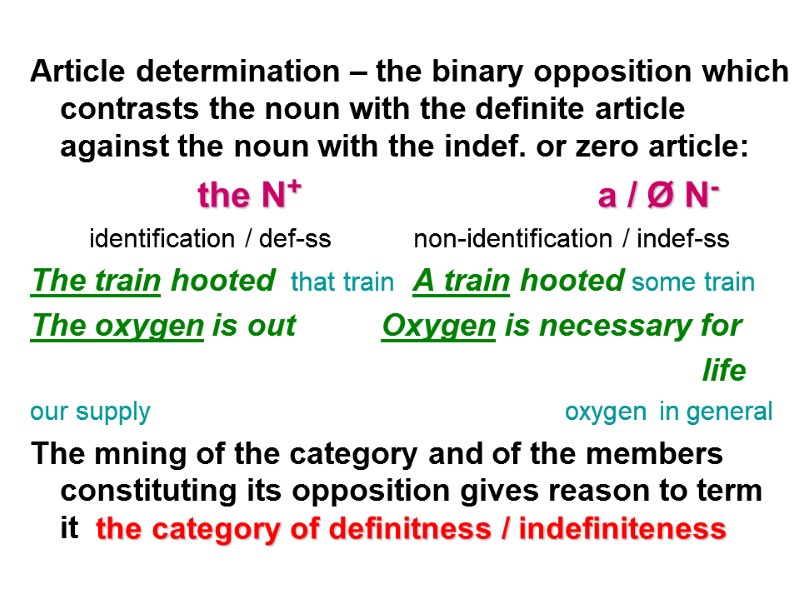
Article determination – the binary opposition which contrasts the noun with the definite article against the noun with the indef. or zero article: the N+ a / Ø N- identification / def-ss non-identification / indef-ss The train hooted that train A train hooted some train The oxygen is out Oxygen is necessary for life our supply oxygen in general The mning of the category and of the members constituting its opposition gives reason to term it the category of definitness / indefiniteness
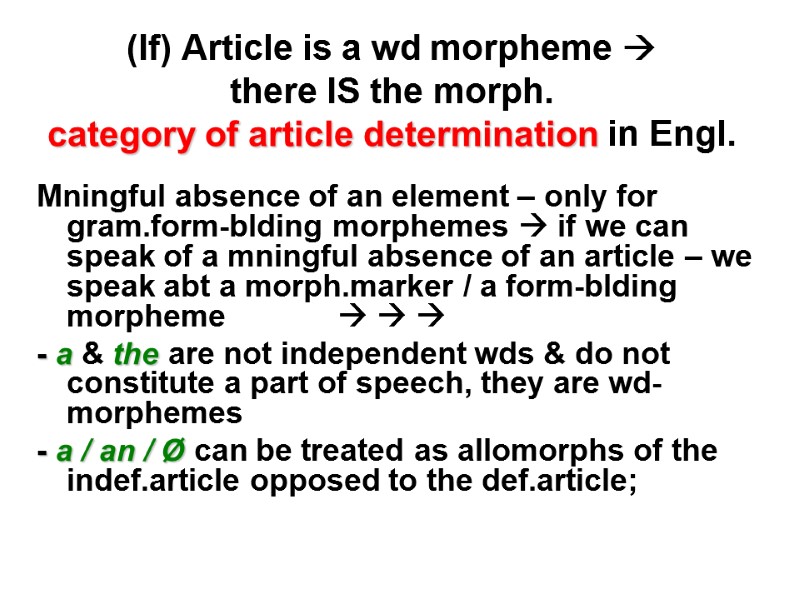
(If) Article is a wd morpheme there IS the morph. category of article determination in Engl. Mningful absence of an element – only for gram.form-blding morphemes if we can speak of a mningful absence of an article – we speak abt a morph.marker / a form-blding morpheme - a & the are not independent wds & do not constitute a part of speech, they are wd-morphemes - a / an / Ø can be treated as allomorphs of the indef.article opposed to the def.article;
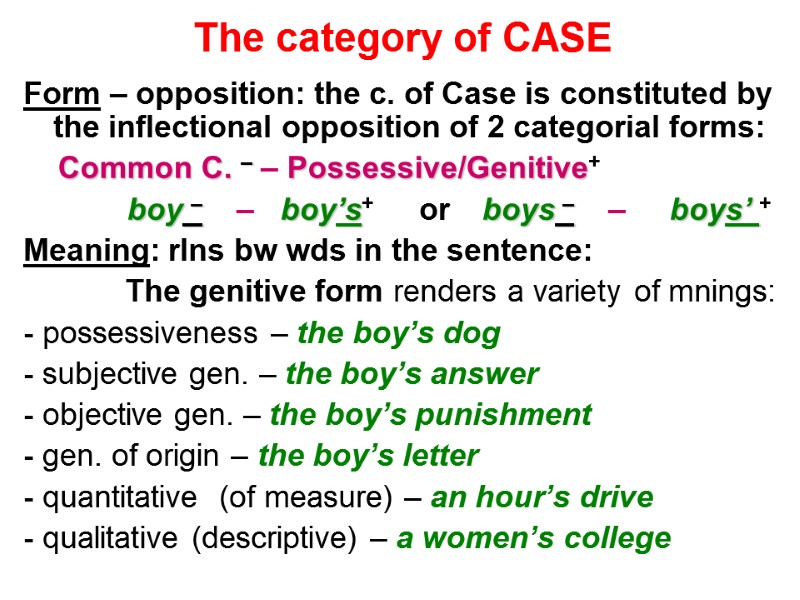
The category of CASE Form – opposition: the c. of Case is constituted by the inflectional opposition of 2 categorial forms: Common C. – – Possessive/Genitive+ boy – – boy’s+ or boys – – boys’ + Meaning: rlns bw wds in the sentence: The genitive form renders a variety of mnings: - possessiveness – the boy’s dog - subjective gen. – the boy’s answer - objective gen. – the boy’s punishment - gen. of origin – the boy’s letter - quantitative (of measure) – an hour’s drive - qualitative (descriptive) – a women’s college
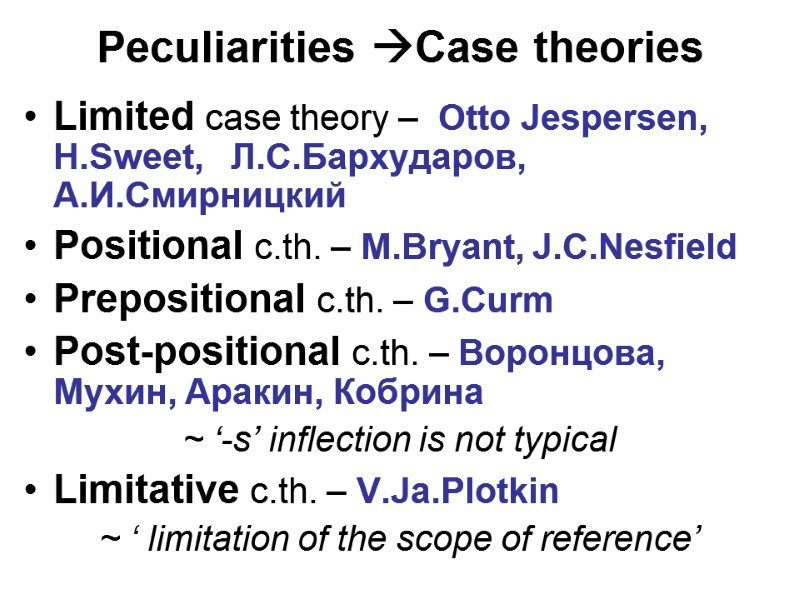
Peculiarities Case theories Limited case theory – Otto Jespersen, H.Sweet, Л.С.Бархударов, А.И.Смирницкий Positional c.th. – M.Bryant, J.C.Nesfield Prepositional c.th. – G.Curm Post-positional c.th. – Воронцова, Мухин, Аракин, Кобрина ~ ‘-s’ inflection is not typical Limitative c.th. – V.Ja.Plotkin ~ ‘ limitation of the scope of reference’
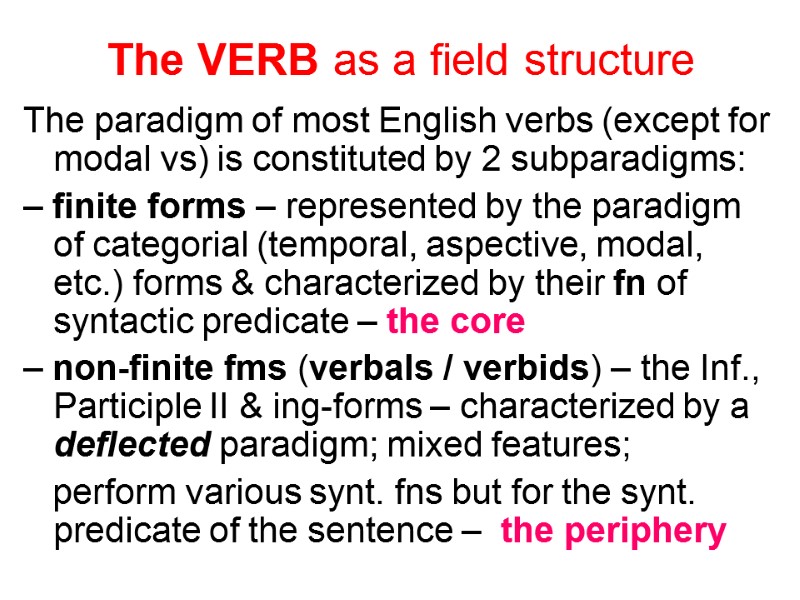
The VERB as a field structure The paradigm of most English verbs (except for modal vs) is constituted by 2 subparadigms: – finite forms – represented by the paradigm of categorial (temporal, aspective, modal, etc.) forms & characterized by their fn of syntactic predicate – the core – non-finite fms (verbals / verbids) – the Inf., Participle II & ing-forms – characterized by a deflected paradigm; mixed features; perform various synt. fns but for the synt. predicate of the sentence – the periphery
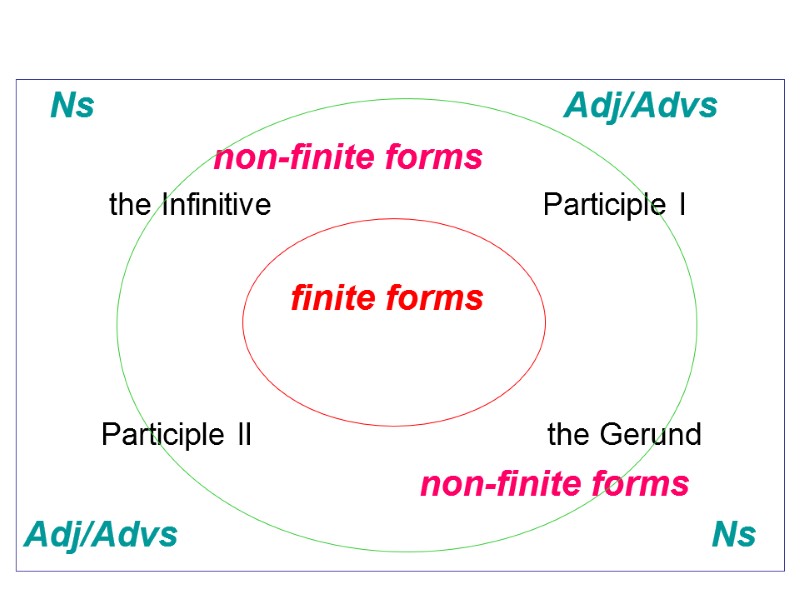
Ns Adj/Advs non-finite forms the Infinitive Participle I finite forms Participle II the Gerund non-finite forms Adj/Advs Ns
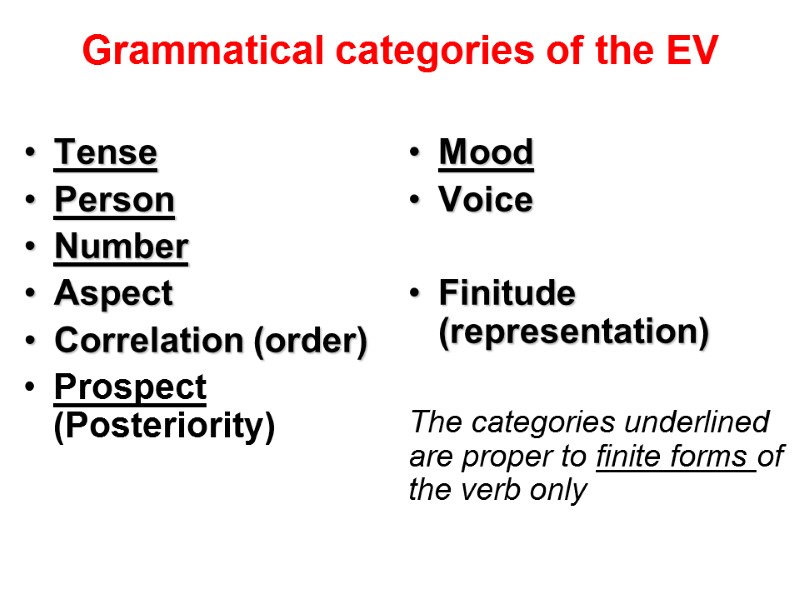
Grammatical categories of the EV Tense Person Number Aspect Correlation (order) Prospect (Posteriority) Mood Voice Finitude (representation) The categories underlined are proper to finite forms of the verb only
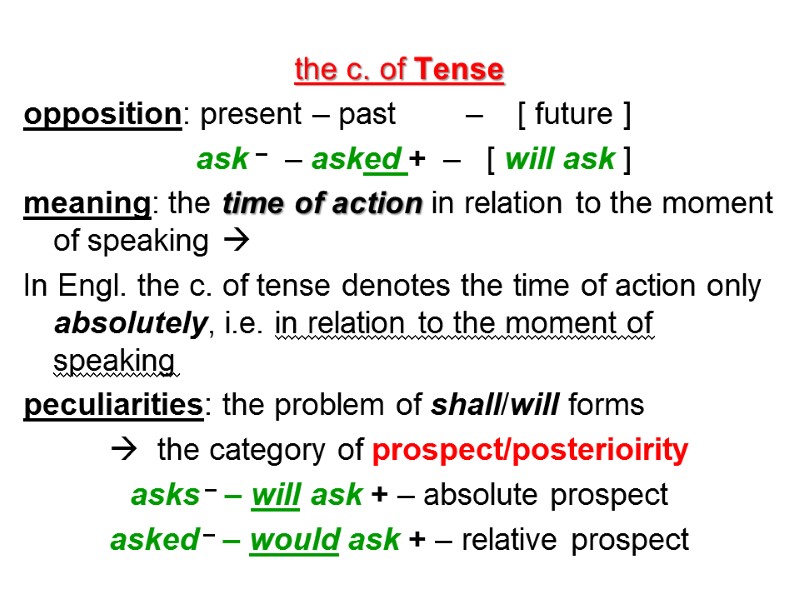
the c. of Tense opposition: present – past – [ future ] ask – – asked + – [ will ask ] meaning: the time of action in relation to the moment of speaking In Engl. the c. of tense denotes the time of action only absolutely, i.e. in relation to the moment of speaking peculiarities: the problem of shall/will forms the category of prospect/posterioirity asks – – will ask + – absolute prospect asked – – would ask + – relative prospect
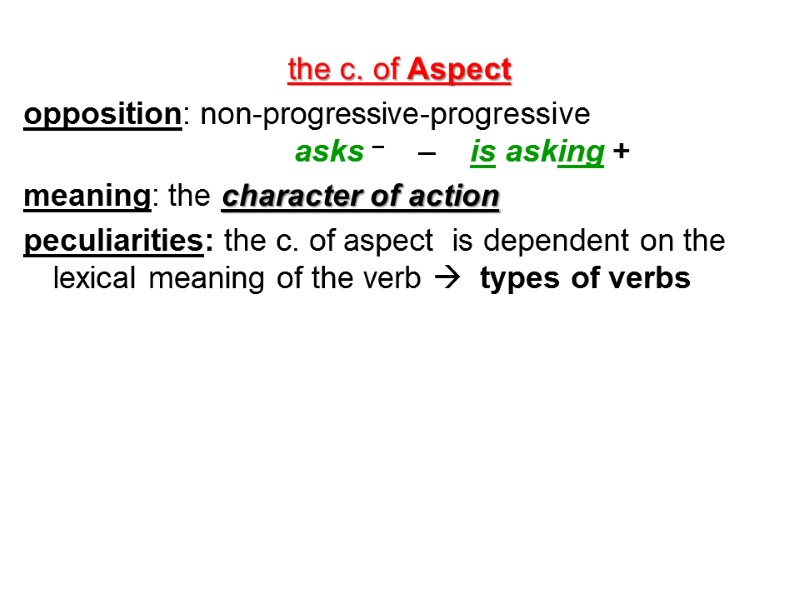
the c. of Aspect opposition: non-progressive-progressive asks – – is asking + meaning: the character of action peculiarities: the c. of aspect is dependent on the lexical meaning of the verb types of verbs
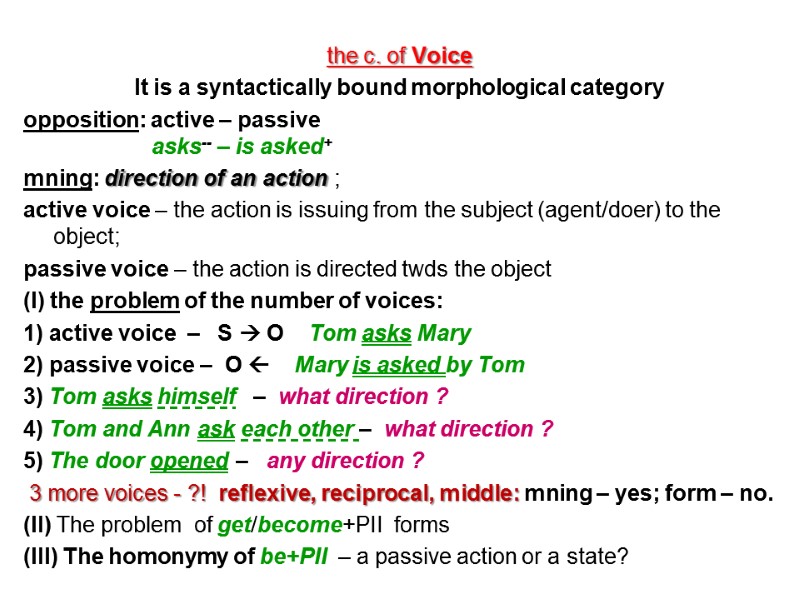
the c. of Voice It is a syntactically bound morphological category opposition: active – passive asks-- – is asked+ mning: direction of an action ; active voice – the action is issuing from the subject (agent/doer) to the object; passive voice – the action is directed twds the object (I) the problem of the number of voices: 1) active voice – S O Tom asks Mary 2) passive voice – O Mary is asked by Tom 3) Tom asks himself – what direction ? 4) Tom and Ann ask each other – what direction ? 5) The door opened – any direction ? 3 more voices - ?! reflexive, reciprocal, middle: mning – yes; form – no. (II) The problem of get/become+PII forms (III) The homonymy of be+PII – a passive action or a state?
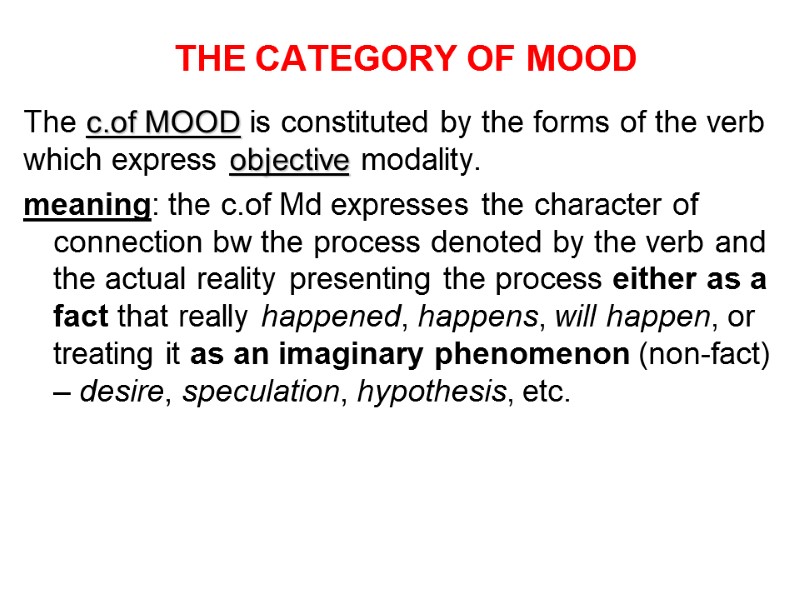
THE CATEGORY OF MOOD The c.of MOOD is constituted by the forms of the verb which express objective modality. meaning: the c.of Md expresses the character of connection bw the process denoted by the verb and the actual reality presenting the process either as a fact that really happened, happens, will happen, or treating it as an imaginary phenomenon (non-fact) – desire, speculation, hypothesis, etc.
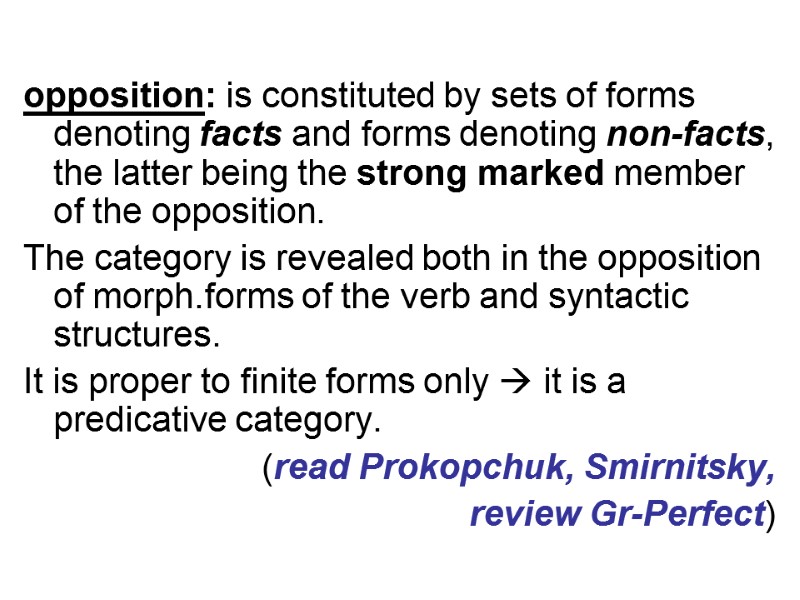
opposition: is constituted by sets of forms denoting facts and forms denoting non-facts, the latter being the strong marked member of the opposition. The category is revealed both in the opposition of morph.forms of the verb and syntactic structures. It is proper to finite forms only it is a predicative category. (read Prokopchuk, Smirnitsky, review Gr-Perfect)
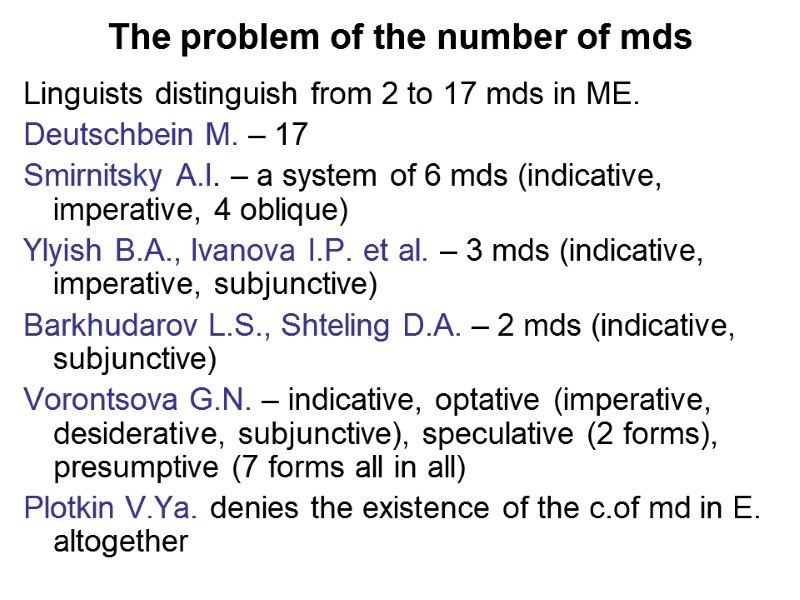
The problem of the number of mds Linguists distinguish from 2 to 17 mds in ME. Deutschbein M. – 17 Smirnitsky A.I. – a system of 6 mds (indicative, imperative, 4 oblique) Ylyish B.A., Ivanova I.P. et al. – 3 mds (indicative, imperative, subjunctive) Barkhudarov L.S., Shteling D.A. – 2 mds (indicative, subjunctive) Vorontsova G.N. – indicative, optative (imperative, desiderative, subjunctive), speculative (2 forms), presumptive (7 forms all in all) Plotkin V.Ya. denies the existence of the c.of md in E. altogether
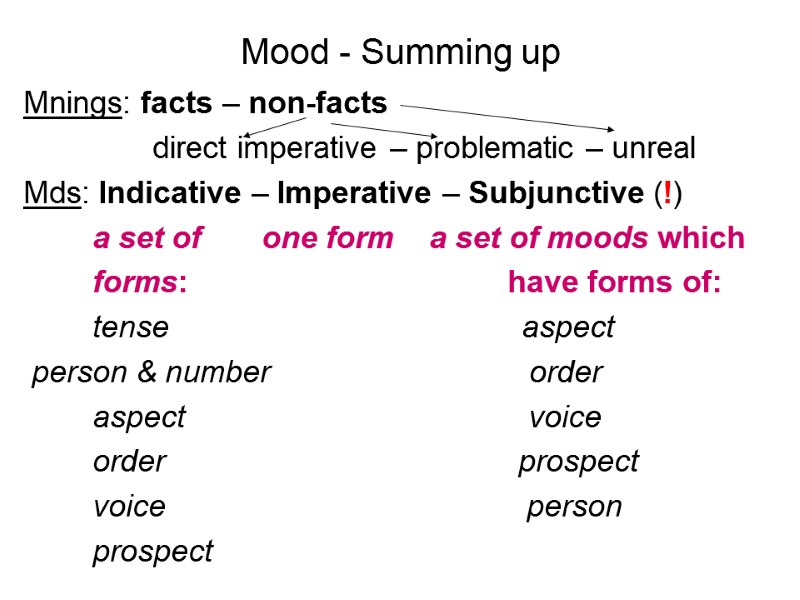
Mood - Summing up Mnings: facts – non-facts direct imperative – problematic – unreal Mds: Indicative – Imperative – Subjunctive (!) a set of one form a set of moods which forms: have forms of: tense aspect person & number order aspect voice order prospect voice person prospect
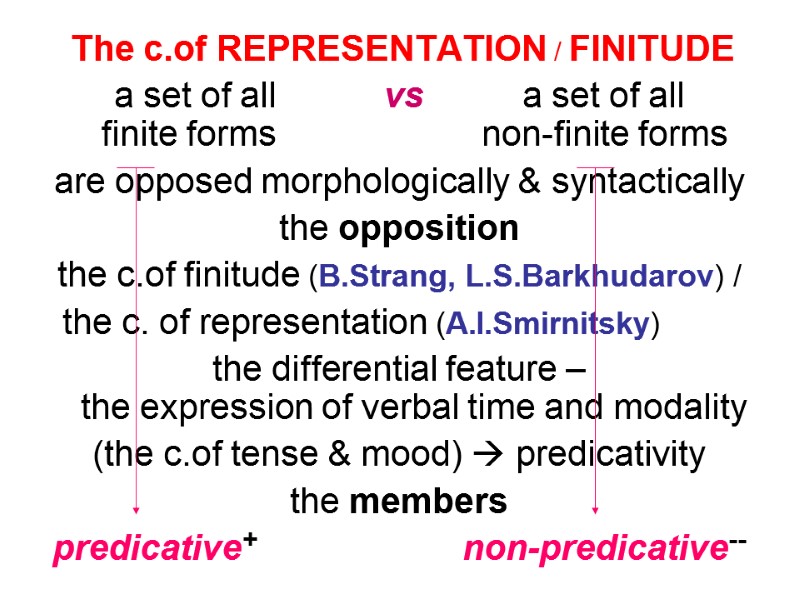
The c.of REPRESENTATION / FINITUDE a set of all vs a set of all finite forms non-finite forms are opposed morphologically & syntactically the opposition the c.of finitude (B.Strang, L.S.Barkhudarov) / the c. of representation (A.I.Smirnitsky) the differential feature – the expression of verbal time and modality (the c.of tense & mood) predicativity the members predicative+ non-predicative--
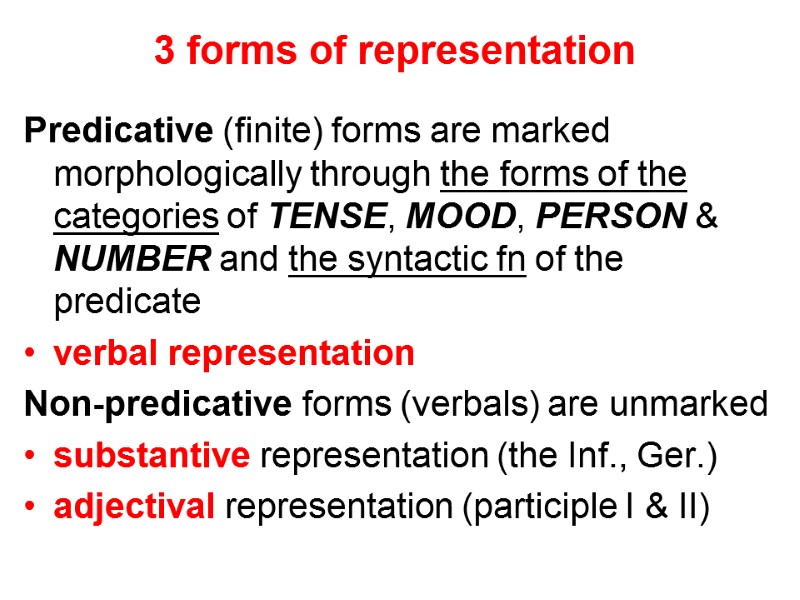
3 forms of representation Predicative (finite) forms are marked morphologically through the forms of the categories of TENSE, MOOD, PERSON & NUMBER and the syntactic fn of the predicate verbal representation Non-predicative forms (verbals) are unmarked substantive representation (the Inf., Ger.) adjectival representation (participle I & II)
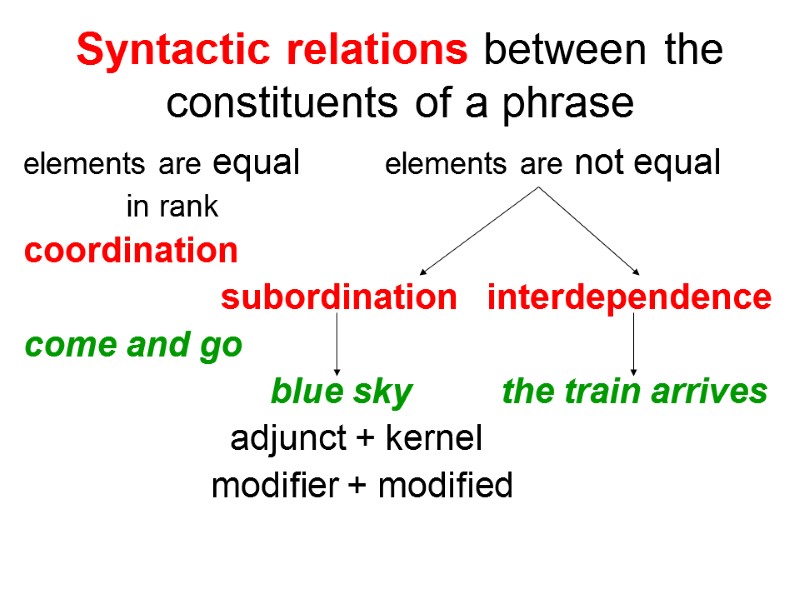
Syntactic relations between the constituents of a phrase elements are equal elements are not equal in rank coordination subordination interdependence come and go blue sky the train arrives adjunct + kernel modifier + modified
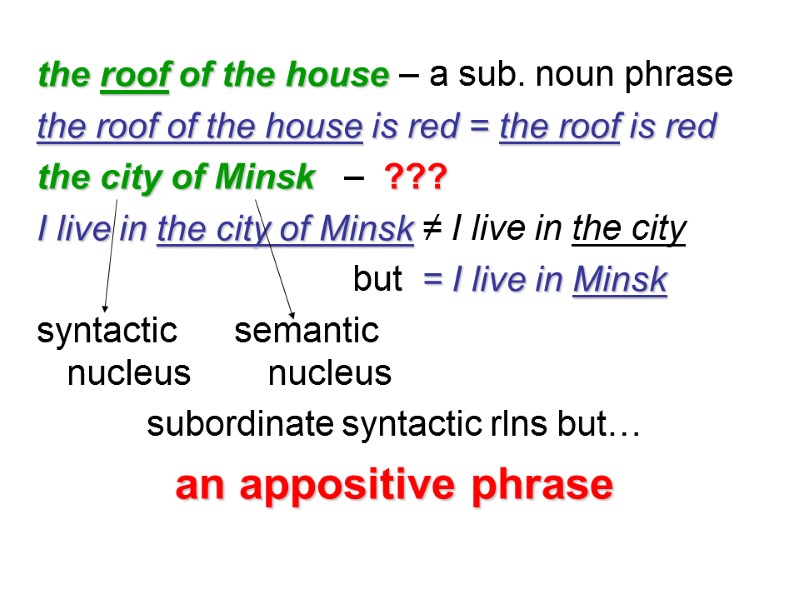
the roof of the house – a sub. noun phrase the roof of the house is red = the roof is red the city of Minsk – ??? I live in the city of Minsk ≠ I live in the city but = I live in Minsk syntactic semantic nucleus nucleus subordinate syntactic rlns but… an appositive phrase
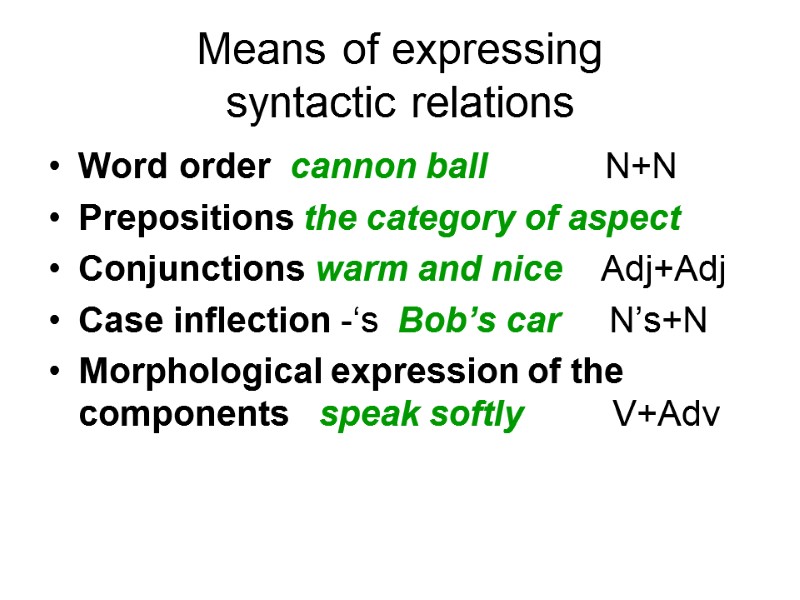
Means of expressing syntactic relations Word order cannon ball N+N Prepositions the category of aspect Conjunctions warm and nice Adj+Adj Case inflection -‘s Bob’s car N’s+N Morphological expression of the components speak softly V+Adv
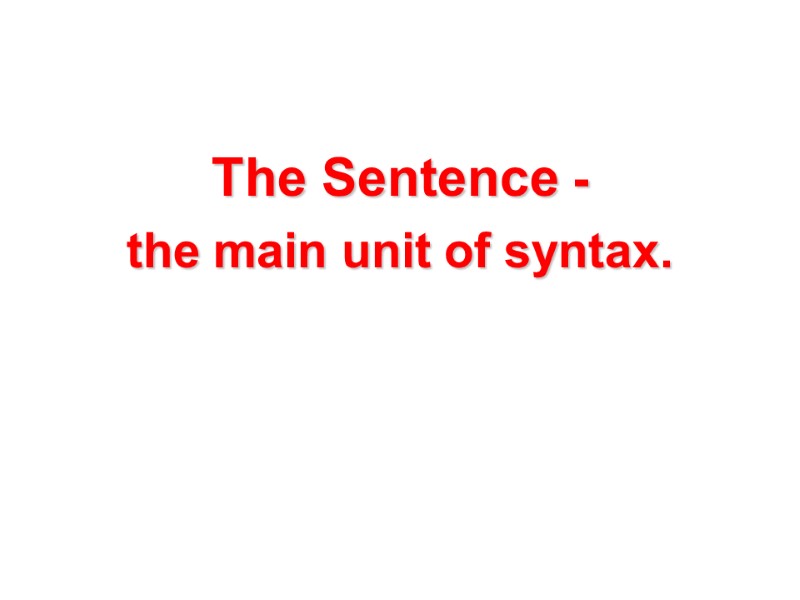
The Sentence - the main unit of syntax.
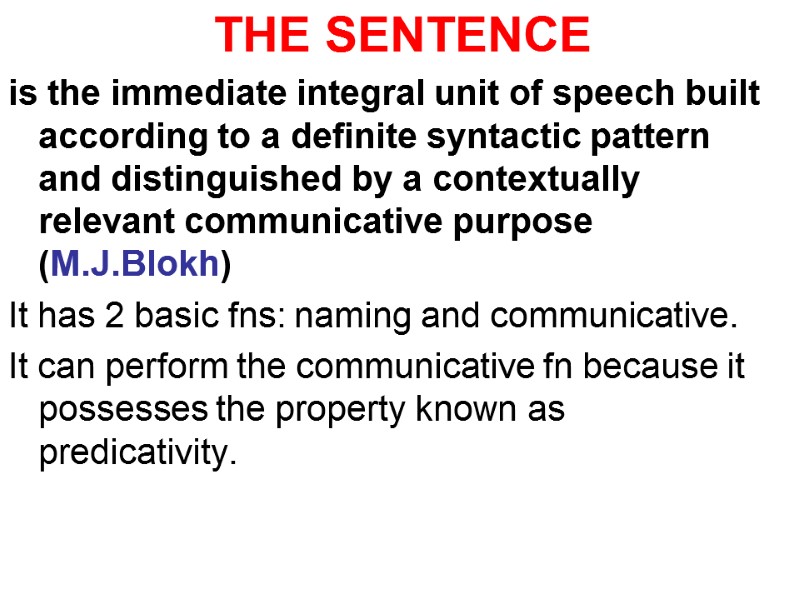
THE SENTENCE is the immediate integral unit of speech built according to a definite syntactic pattern and distinguished by a contextually relevant communicative purpose (M.J.Blokh) It has 2 basic fns: naming and communicative. It can perform the communicative fn because it possesses the property known as predicativity.
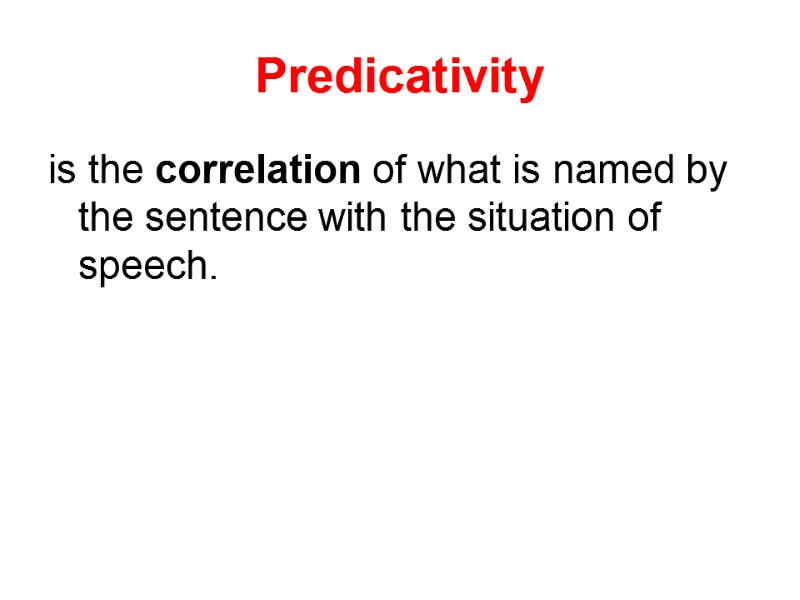
Predicativity is the correlation of what is named by the sentence with the situation of speech.
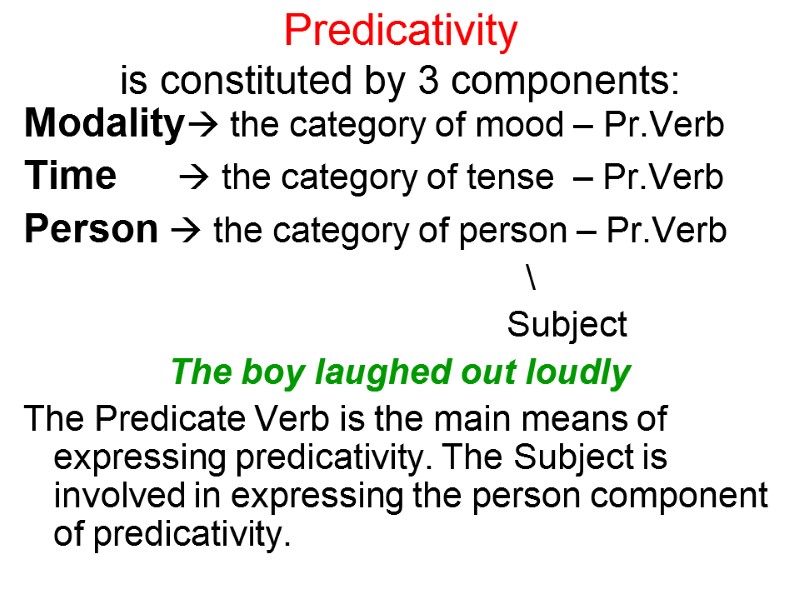
Predicativity is constituted by 3 components: Modality the category of mood – Pr.Verb Time the category of tense – Pr.Verb Person the category of person – Pr.Verb \ Subject The boy laughed out loudly The Predicate Verb is the main means of expressing predicativity. The Subject is involved in expressing the person component of predicativity.
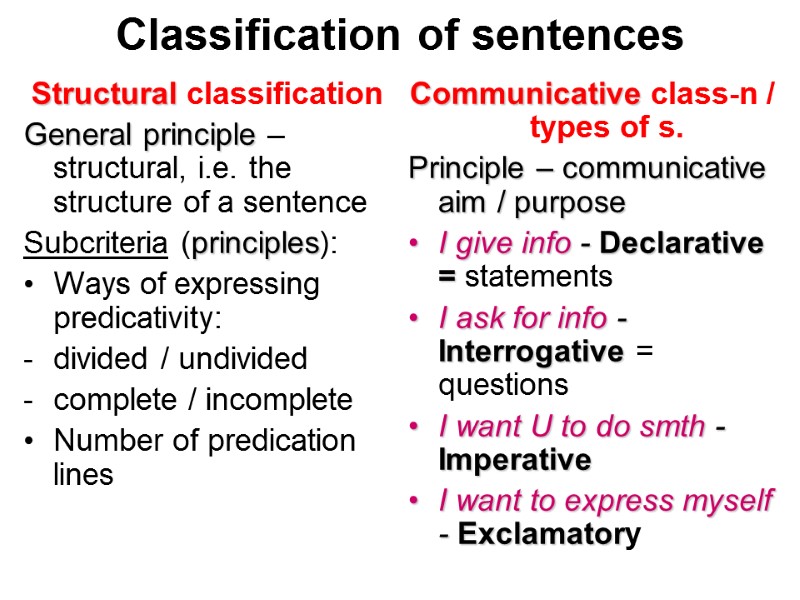
Classification of sentences Structural classification General principle – structural, i.e. the structure of a sentence Subcriteria (principles): Ways of expressing predicativity: divided / undivided complete / incomplete Number of predication lines Communicative class-n / types of s. Principle – communicative aim / purpose I give info - Declarative = statements I ask for info - Interrogative = questions I want U to do smth - Imperative I want to express myself - Exclamatory
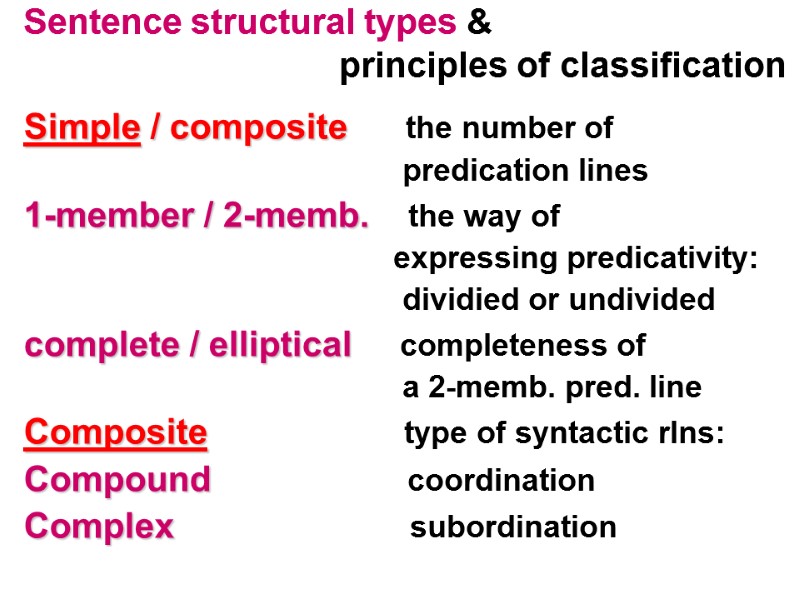
Sentence structural types & principles of classification Simple / composite the number of predication lines 1-member / 2-memb. the way of expressing predicativity: dividied or undivided complete / elliptical completeness of a 2-memb. pred. line Composite type of syntactic rlns: Compound coordination Complex subordination
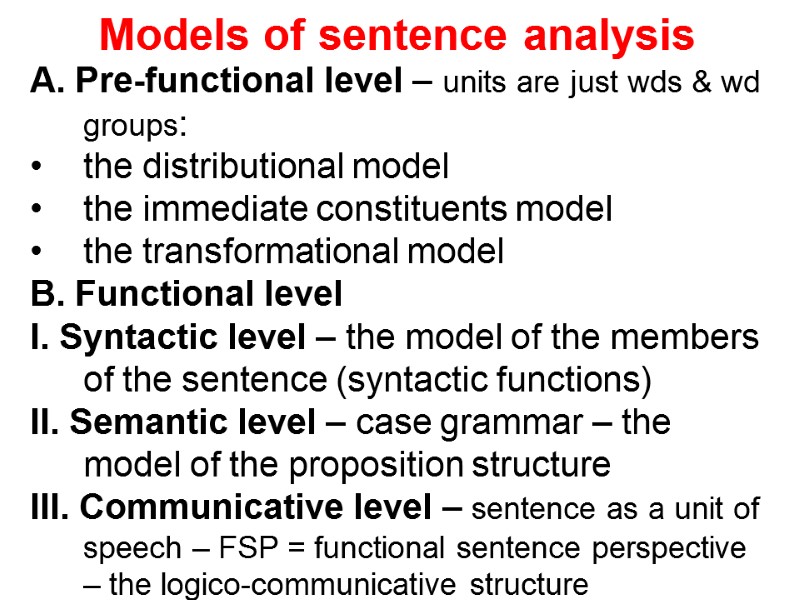
Models of sentence analysis A. Pre-functional level – units are just wds & wd groups: the distributional model the immediate constituents model the transformational model B. Functional level I. Syntactic level – the model of the members of the sentence (syntactic functions) II. Semantic level – case grammar – the model of the proposition structure III. Communicative level – sentence as a unit of speech – FSP = functional sentence perspective – the logico-communicative structure
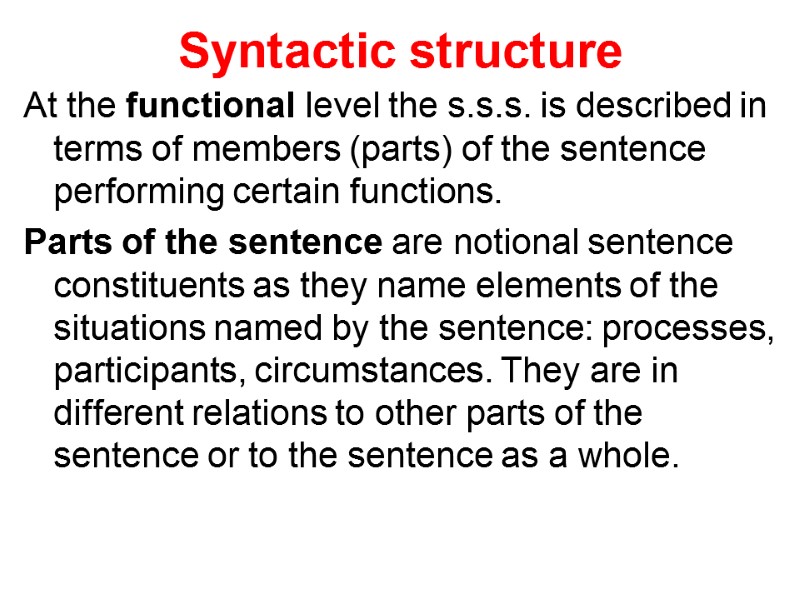
Syntactic structure At the functional level the s.s.s. is described in terms of members (parts) of the sentence performing certain functions. Parts of the sentence are notional sentence constituents as they name elements of the situations named by the sentence: processes, participants, circumstances. They are in different relations to other parts of the sentence or to the sentence as a whole.
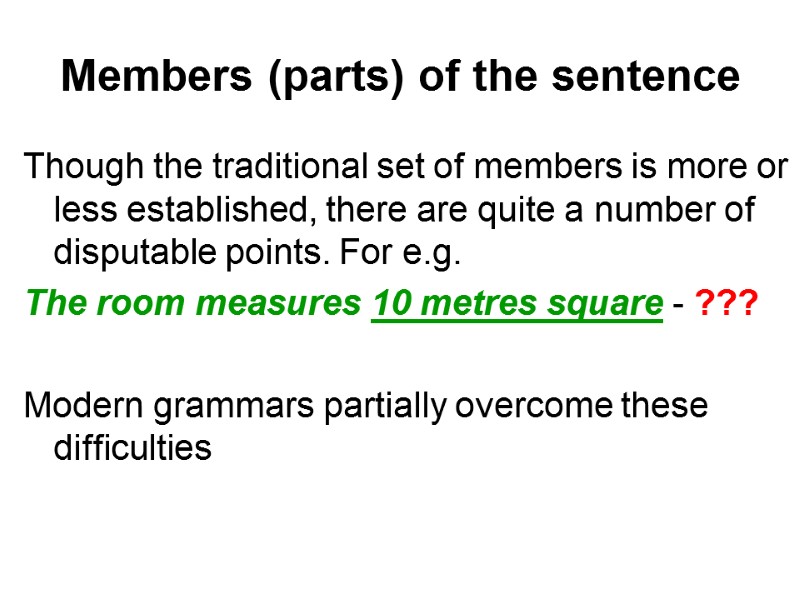
Members (parts) of the sentence Though the traditional set of members is more or less established, there are quite a number of disputable points. For e.g. The room measures 10 metres square - ??? Modern grammars partially overcome these difficulties
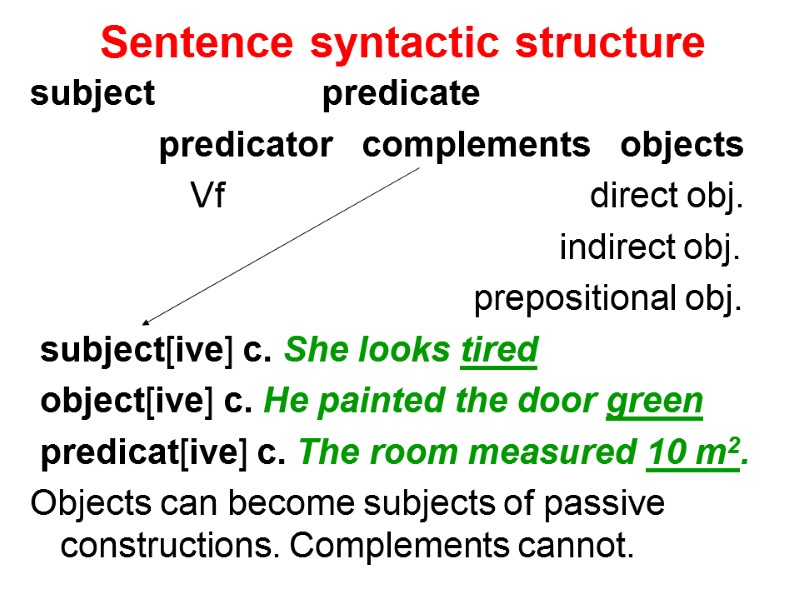
Sentence syntactic structure subject predicate predicator complements objects Vf direct obj. indirect obj. prepositional obj. subject[ive] c. She looks tired object[ive] c. He painted the door green predicat[ive] c. The room measured 10 m2. Objects can become subjects of passive constructions. Complements cannot.
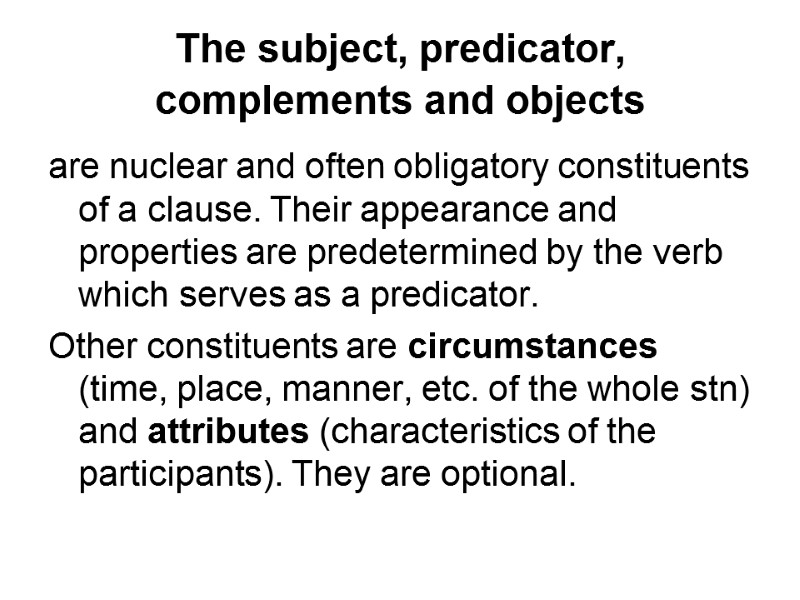
The subject, predicator, complements and objects are nuclear and often obligatory constituents of a clause. Their appearance and properties are predetermined by the verb which serves as a predicator. Other constituents are circumstances (time, place, manner, etc. of the whole stn) and attributes (characteristics of the participants). They are optional.
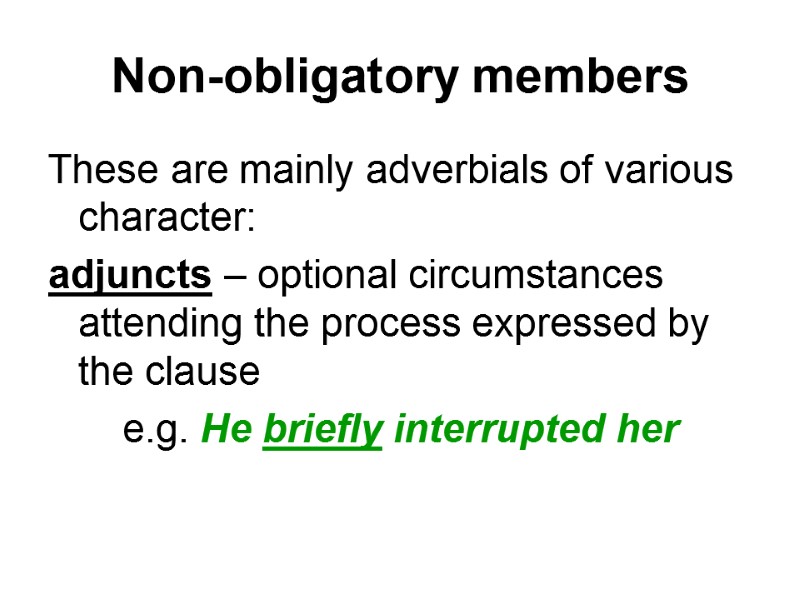
Non-obligatory members These are mainly adverbials of various character: adjuncts – optional circumstances attending the process expressed by the clause e.g. He briefly interrupted her
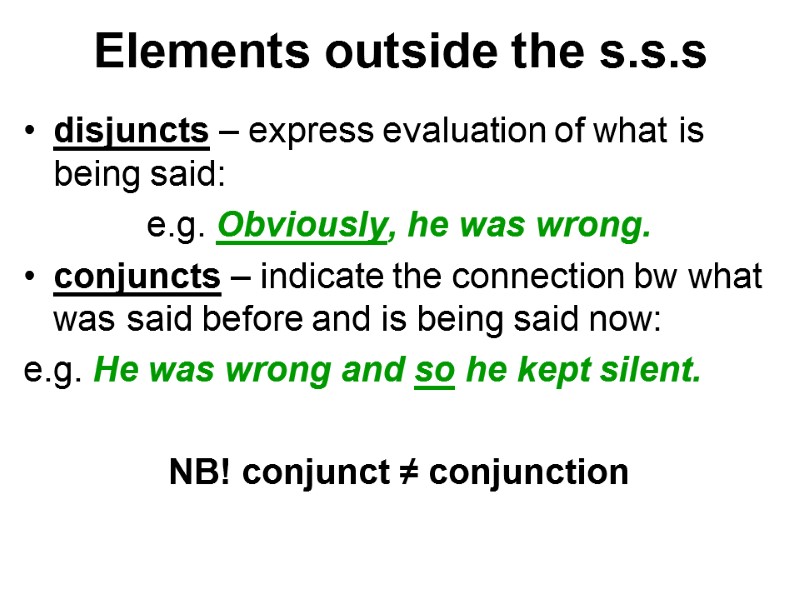
Elements outside the s.s.s disjuncts – express evaluation of what is being said: e.g. Obviously, he was wrong. conjuncts – indicate the connection bw what was said before and is being said now: e.g. He was wrong and so he kept silent. NB! conjunct ≠ conjunction
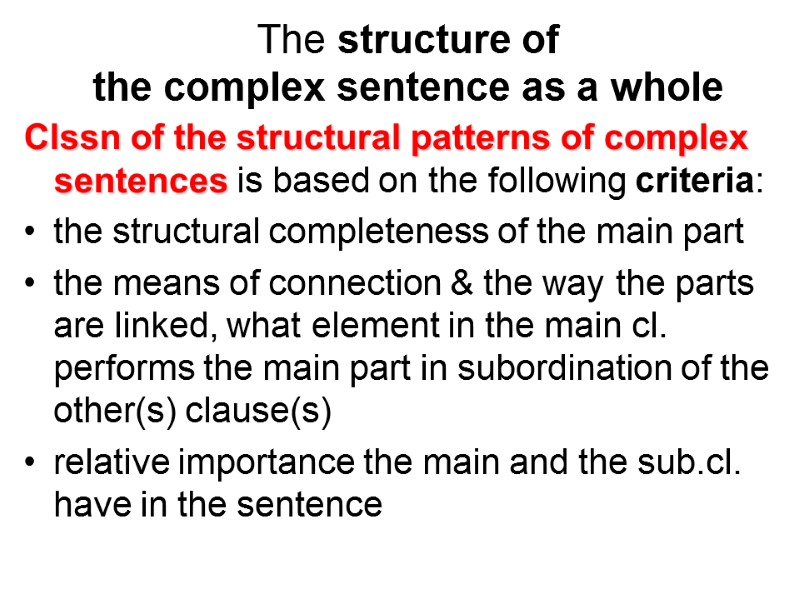
The structure of the complex sentence as a whole Clssn of the structural patterns of complex sentences is based on the following criteria: the structural completeness of the main part the means of connection & the way the parts are linked, what element in the main cl. performs the main part in subordination of the other(s) clause(s) relative importance the main and the sub.cl. have in the sentence
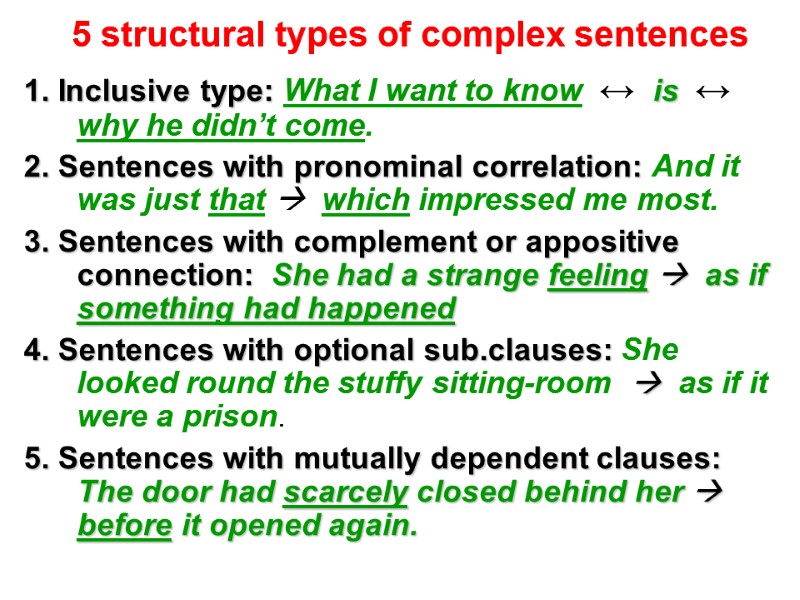
5 structural types of complex sentences 1. Inclusive type: What I want to know ↔ is ↔ why he didn’t come. 2. Sentences with pronominal correlation: And it was just that which impressed me most. 3. Sentences with complement or appositive connection: She had a strange feeling as if something had happened 4. Sentences with optional sub.clauses: She looked round the stuffy sitting-room as if it were a prison. 5. Sentences with mutually dependent clauses: The door had scarcely closed behind her before it opened again.
6182-th_gr_some_for_inter-intranet.ppt
- Количество слайдов: 54

